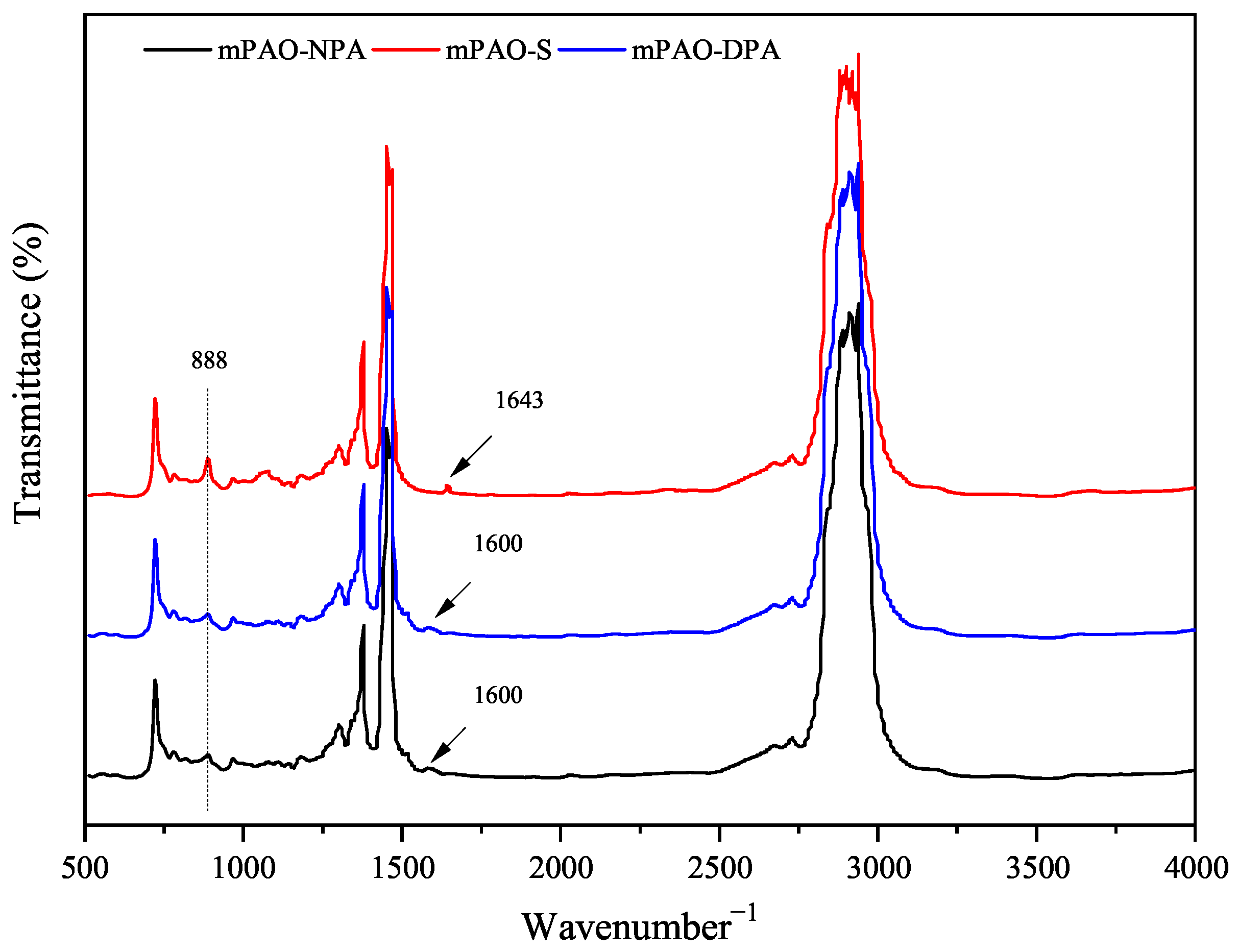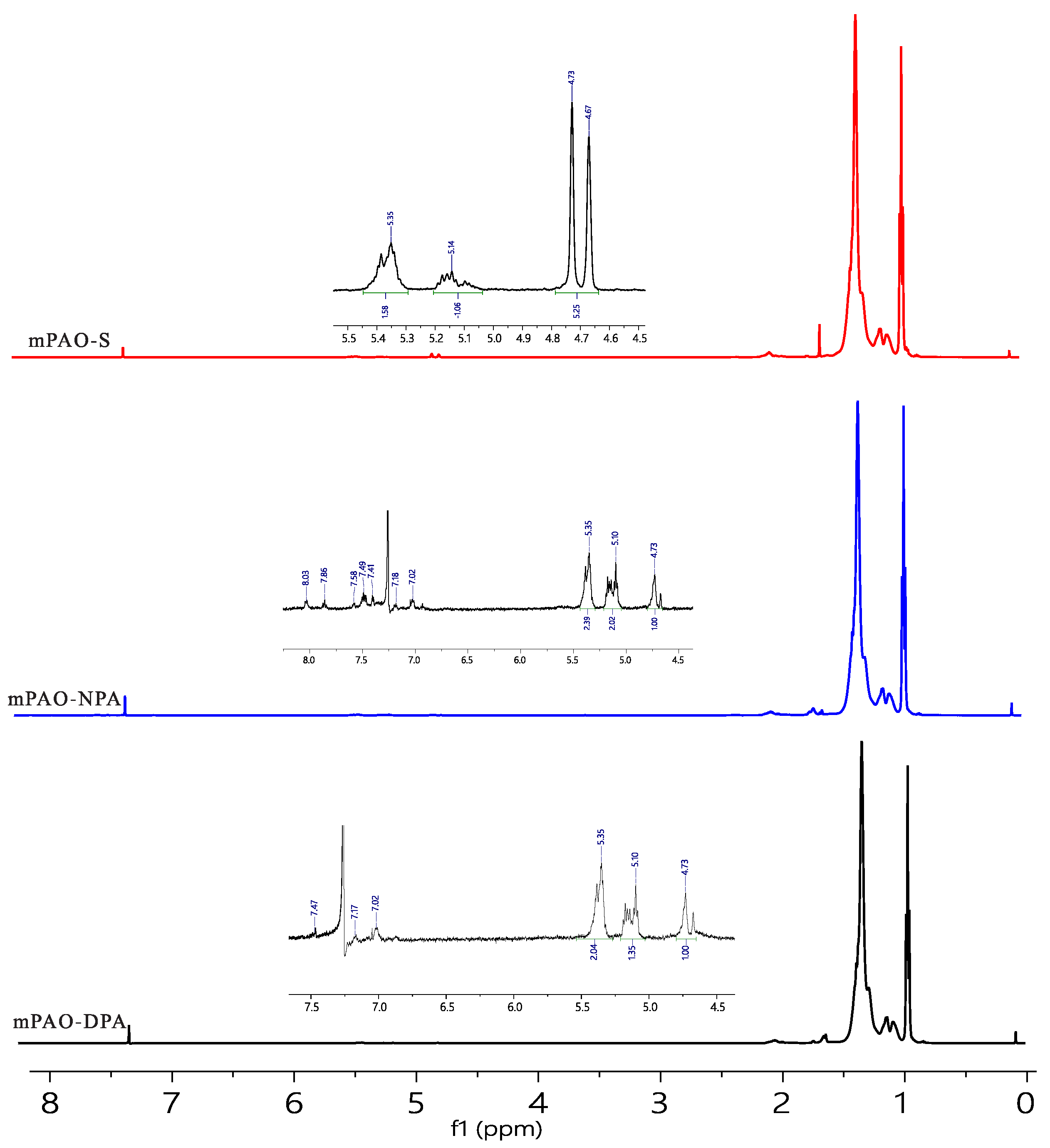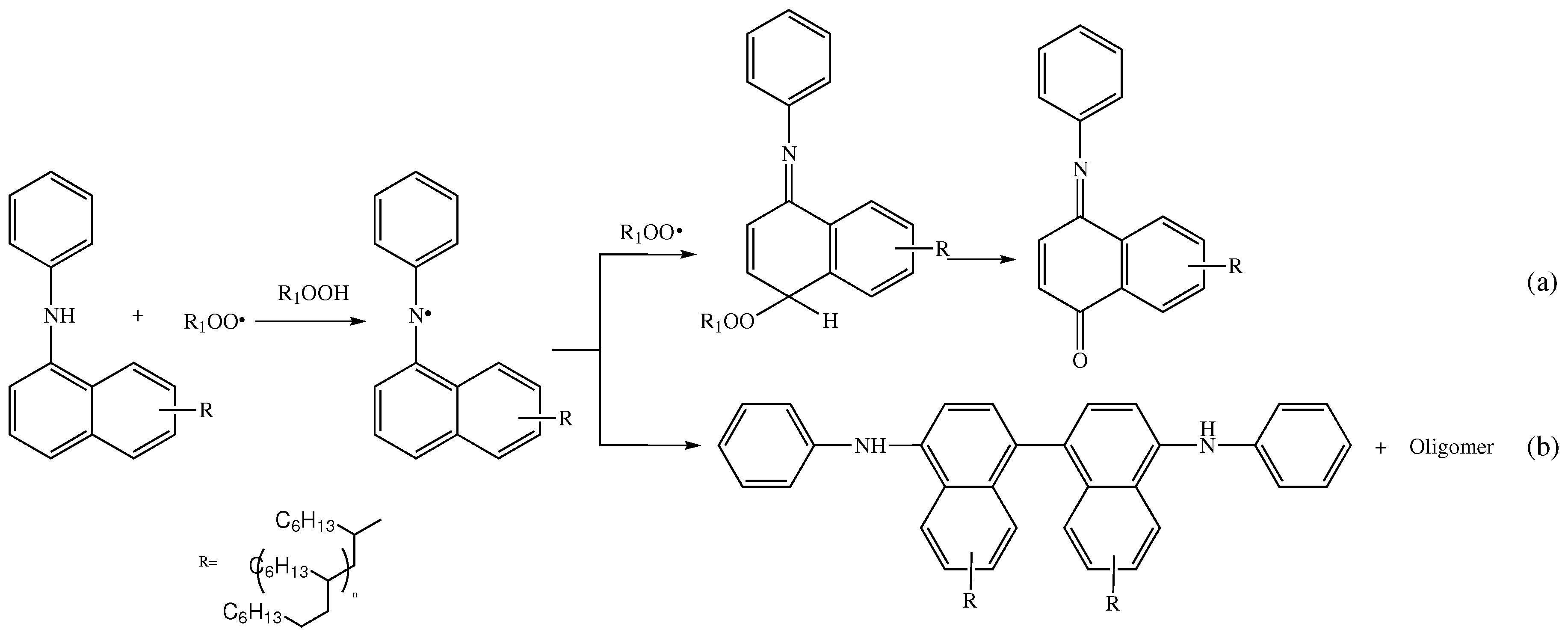Performance of Aromatic Amine-Modified Metallocene Polyalphaolefin Lubricant Base Oil
Abstract
:1. Introduction
2. Materials and Methods
2.1. Synthesis Procedures
2.1.1. Synthesis of High-Viscosity Metallocene Poly--Olefins (mPAO-S)
2.1.2. Synthesis of the [BMI]Al2Cl7 Ionic Liquid Catalyst
2.1.3. Synthesis of mPAO-NPA
2.1.4. Synthesis of mPAO-DPA
2.1.5. Formulation of ISO 320 Gear Oil
2.2. Physicochemical Properties Test
2.3. Structural Composition Analysis
2.4. Oxidation and Thermal Stability
2.5. Friction and Wear Test
3. Results
3.1. Physicochemical Characterization
3.2. Fourier Transform Infrared Spectra of mPAO-S and Its Derivatives
3.3. 1H NMR Spectra of mPAO and Its Derivatives
3.4. Aromatic Content, Nitrogen Content, and Molecular Weight
3.5. Thermal Oxidative Stability
3.6. Evaluation of VG 320 Industrial Gear Oils
4. Conclusions
- (1)
- Through 1H NMR, FTIR, and elemental composition analysis, it was confirmed that the alkylation reaction proceeded with monoalkyl substitution. Up to 88% of vinylidene in mPAO was saturated by alkylation.
- (2)
- After being alkylated with aromatic amines, the two prepared samples, mPAO-DPA and mPAO-NPA, showed a slight increase in molecular weight and viscosity compared with mPAO-S, while the viscosity index decreased slightly.
- (3)
- Compared with mPAO-S, the initial oxidation temperature of mPAO-DPA and mPAO-NPA, respectively, increased by 33 and 53 °C, while the oxidation induction period increased by 11 and 20 min, respectively. The initial decomposition temperatures of both (315 and 318 °C) were higher than those of mPAO-S and PAO100 (304 and 306 °C, respectively).
- (4)
- Compared with Lub-1, the ROBT induction period of Lub-2 increased by 30%, reaching 471 min. After 144 h of oxidation, the viscosity of Lub-1 at 40 °C began to increase rapidly, while the acid number of Lub-2 was 1.6 times that of Lub-1 after 288 h of oxidation.
- (5)
- The mPAO base oil modified with N-phenyl--naphthalamine showed a certain synergistic effect with the HiTEC 3339 additive, enabling the rapid formation of a more stable oil film and reducing the wear scar diameter.
Author Contributions
Funding
Data Availability Statement
Conflicts of Interest
References
- Lian, B.; Beckerle, K.; Spaniol, T.; Okuda, J. Regioselective 1-hexene oligomerization using cationic bis(phenolato) group 4 metal catalysts: Switch from 1,2-to 2,1-Insertion. Angew. Chem. Int. Ed. 2007, 46, 8507–8510. [Google Scholar] [CrossRef] [PubMed]
- Ray, S.; Rao, P.V.C.; Choudary, N.V. Poly-α-olefin-based synthetic lubricants: A short review on various synthetic routes. Lubr. Sci. 2012, 24, 23–44. [Google Scholar] [CrossRef]
- Sun, H.; Shen, B.; Wu, D.; Guo, X.; Li, D. Supported Al-Ti bimetallic catalysts for 1-decene oligomerization: Activity, stability and deactivation mechanism. J. Catal. 2016, 339, 84–92. [Google Scholar] [CrossRef]
- Bialek, M.; Bisz, E. A comparative study on the polymerization of 1-octene promoted by vanadium and titanium complexes supported by phenoxyimine and salen type ligands. J. Polym. Res. 2013, 20, 164–172. [Google Scholar] [CrossRef]
- Hogg, J.M.; Ferrer-Ugalde, A.; Coleman, F.; Swadzba-Kwasny, M. Borenium ionic liquids as alternative to BF3 in poly-α-olefins (PAOs) synthesis. ACS Sustain. Chem. Eng. 2019, 7, 15044–15052. [Google Scholar] [CrossRef]
- Yadav, G.D.; Doshi, N.S. Development of a green process for poly-α-olefin based lubricants. Green Chem. 2002, 4, 528–540. [Google Scholar] [CrossRef]
- Benda, R.; Bullen, J.; Plomer, A. Synthetics basics: Polyalphaolefins-base fluids for modern heavy duty diesel oils. J. Synth. Lubr. 1998, 15, 117–132. [Google Scholar] [CrossRef]
- Ahad, H.; Naeimeh, B.; Ali, M.; Mehdi, N. Oligomerization of higher α-olefins to poly(α-olefins). Iran. Polym. J. 2022, 31, 107–126. [Google Scholar]
- Hope, K. PAO contributions to energy efficiency in 0W-20 passenger car Engine oils. Lubricants 2018, 6, 73. [Google Scholar] [CrossRef]
- Nikunj, P.; Vaibhav, V.; Gopal, T. Recent developments in catalyst systems for selective oligomerization and polymerization of higher α-olefins. Polym. Chem. 2023, 14, 2542–2571. [Google Scholar]
- Shao, H.; Gu, X.; Wang, R.; Wang, X.; Jiang, T.; Guo, X. Preparation of lubricant base stocks with high viscosity index through 1-decene oligomerization catalyzed by alkylaluminum chloride promoted by metal chloride. Energy Fuel 2020, 34, 2214–2220. [Google Scholar] [CrossRef]
- Matkovskii, P.; Startseva, G.; Churkina, V.; Knerel’man, E.; Davydova, G.; Vasil’eva, L.; Yarullin, R. Oligomerization of 1-decene under the action of catalytic systems based on Al–Aluminum activator–RCl and Al–RCl. Polym. Sci. Ser. A 2008, 50, 1175–1186. [Google Scholar] [CrossRef]
- Haraguchi, R.; Nishikawa, T.; Kanazawa, A.; Aoshima, S. Metal-free living cationic polymerization using diaryliodonium salts as organic lewis acid catalysts. Macromolecules 2020, 53, 4185–4192. [Google Scholar] [CrossRef]
- Wasserscheid, P.; Grimm, S.; Köhn, R.D.; Haufe, M. Synthesis of synthetic lubricants by trimerization of 1-decene and 1-dodecene with homogeneous chromium catalysts. Adv. Synth. Catal. 2001, 343, 814–818. [Google Scholar] [CrossRef]
- Ding, H.; Zhang, B.Y.; Liu, J. Study on preparation process of lubrication from 1-decene with acidic ionic liquid catalyst. Pet. Sci. Technol. 2009, 27, 1919–1925. [Google Scholar] [CrossRef]
- Techopittayakul, T.; Echaroj, S.; Santikunaporn, M.; Asavatesanupap, C.; Chen, H.; Yuan, M. Kinetic modeling of 1-decene oligomerization to synthetic fuels and base oil over tungstated-zirconia catalyst. React. Kinet. Mech. Catal. 2019, 126, 529–546. [Google Scholar] [CrossRef]
- Nifant’ev, I.E.; Vinogradov, A.A.; Vinogradov, A.A.; Bagrov, V.V.; Churakov, A.V.; Minyaev, M.E.; Kiselev, A.; Salakhov, I.; Ivchenko, P.V. A competitive way to low-viscosity PAO base stocks via heterocene-catalyzed oligomerization of dec-1-ene. Mol. Catal. 2022, 529, 112542. [Google Scholar] [CrossRef]
- Hanifpour, A.; Bahri-Laleha, N.; Nekoomanesh-Haghighia, M.; Poater, A. Group IV diamine bis(phenolate) catalysts for 1-decene oligomerization. Mol. Catal. 2020, 493, 111047. [Google Scholar] [CrossRef]
- Nomura, K.; Pengoubol, S.; Apisuk, W. Synthesis of ultrahigh molecular weight polymers by homopolymerisation of higher α-olefins catalysed by aryloxo-modified half-titanocenes. RSC Adv. 2016, 6, 16203–16206. [Google Scholar] [CrossRef]
- Tanja, H.; Ritter, H. Homogeneous and heterogeneous oligomerization reactions of olefins with unbridged metallocene catalysts. Polyolefins J. 2019, 6, 107–116. [Google Scholar]
- Mashayekhi, M.; Talebi, S.; Sadjadi, S.; Bahri-Laleh, N. Production of polyalfaolefin-based lubricants using new (poly)ionic liquid/AlCl3 catalysts as environmentally friendly alternatives to commercial AlCl3 route. Appl. Catal. A-Gen 2021, 623, 118274. [Google Scholar] [CrossRef]
- Nifant’ev, I.E.; Vinogradov, A.A.; Sedov, I.V.; Dorokhov, V.G.; Lyadov, A.S.; Ivchenko, P.V. Structurally uniform 1-hexene, 1-octene, and 1-decene oligomers: Zirconocene/MAO-catalyzed preparation, characterization, and prospects of their use as low-viscosity low-temperature oil base stocks. Appl. Catal. A-Gen 2018, 549, 40–50. [Google Scholar] [CrossRef]
- Shao, H.; Wang, R.; Li, H.; Guo, X.; Jiang, T. Synthesis of low-molecular-weight poly-a-olefins using silicon-bridged zirconocene catalyst for lubricant basestock. Arab. J. Chem. 2020, 13, 2715–2721. [Google Scholar] [CrossRef]
- Jalali, A.; Nekoomanehs-Haghighi, M.; Dehghani, S.; Bahri-Laleh, N. Effect of metal type on the metallocene-catalyzed oligomerization of 1-hexene and 1-octene to produce polyα-olefin-based synthetic lubricants. Appl. Organomet. Chem. 2020, 34, e5338. [Google Scholar] [CrossRef]
- Kim, I.; Zhou, J.; Chung, H. Higher a-olefin polymerizations catalyzed by rac-Me2Si(1–C5H2-2-CH3-4-tBu)2Zr(NMe2)2/Al(iBu)3/[Ph3C][B(C6F5)4]. J. Polym. Sci. Part A Polym. Chem. 2000, 38, 1687–1697. [Google Scholar] [CrossRef]
- Zhao, Y.; Xu, X.; Wang, Y.; Liu, T.; Li, H.; Zhang, Y.; Wang, L.; Wang, X.; Zhao, S.; Luo, Y. Ancillary ligand effects on a-olefin polymerization catalyzed by zirconium metallocene:a computational study. RSC Adv. 2022, 12, 21111–21121. [Google Scholar] [CrossRef]
- Ahad, H.; Naeimeh, B.; Mehdi, N.H.; Albert, P. Coordinative chain transfer polymerization of 1-decene in the presence of a Ti-based diamine bis(phenolate) catalyst: A sustainable approach to produce low viscosity PAOs. Green Chem. 2020, 22, 4617–4626. [Google Scholar]
- Boris, Z.; Morteza, N.; Boris, B. The effects of the lubricant properties and surface finish characteristics on the tribology of high-speed gears for EV transmissions. Lubricants 2024, 12, 112. [Google Scholar] [CrossRef]
- Martin, G. Pressure viscosity coefficients and traction properties of synthetic lubricants for wind turbine gear systems. Lubr. Sci. 2012, 24, 75–83. [Google Scholar]
- Hyun, S. Designing automotive gear oils for the new millennium. Lubr. Sci. 2002, 14, 385–469. [Google Scholar]
- ISO 12925-1:2024; Lubricants, Industrial Oils and Related Products (Class L)-Family C (Gears)-Part1: Specifications for Lubricants for Enclosed Gear Systems. International Organization for Standardization: Geneva, Switzerland, 2024.
- ASTM D445-24; D02.07, Standard Test Method for Kinematic Viscosity of Transparent and Opaque Liquids (and Calculation of Dynamic Viscosity). ASTM International: West Conshohocken, PA, USA, 2024; p. 16.
- ASTM D2270-10R16; D02.07, Standard Practice for Calculating Viscosity Index From Kinematic Viscosity at 40 °C and 100 °C. ASTM International: West Conshohocken, PA, USA, 2016; p. 5.
- ASTM D92-18; D02.08, Standard Test Method for Flash and Fire Points by Cleveland Open Cup Tester. ASTM International: West Conshohocken, PA, USA, 2018; p. 11.
- ASTM D5950-02; D02.07, Standard Test Method for Pour Point of Petroleum Products (Automatic Tilt Method). ASTM International: West Conshohocken, PA, USA, 2002; p. 5.
- ASTM D1159-07; D02.06, Standard Test Method for Bromine Numbers of Petroleum Distillates and Commercial Aliphatic Olefins by Electrometric Titration. ASTM International: West Conshohocken, PA, USA, 2018; p. 10.
- ASTM D664-24; D02.06, Standard Test Method for Acid Number of Petroleum Products by Potentiometric Titration. ASTM International: West Conshohocken, PA, USA, 2024; p. 12.
- ASTM D611-12; D02.04.0D, Standard Test Methods for Aniline Point and Mixed Aniline Point of Petroleum Products and Hydrocarbon Solvents. ASTM International: West Conshohocken, PA, USA, 2016; p. 7.
- ASTM D5762-18a; D02.03, Standard Test Method for Nitrogen in Liquid Hydrocarbons, Petroleum and Petroleum Products by Boat-Inlet Chemiluminescence. ASTM International: West Conshohocken, PA, USA, 2018; p. 6.
- ASTM D1840-22; D02.04.0F, Standard Test Method for Naphthalene Hydrocarbons in Aviation Turbine Fuels by Ultraviolet Spectrophotometry. ASTM International: West Conshohocken, PA, USA, 2023; p. 4.
- ASTM D3895-19; D20.30, Standard Test Method for Oxidative-Induction Time of Polyolefins by Differential Scanning Calorimetry. ASTM International: West Conshohocken, PA, USA, 2023; p. 7.
- ASTM D2272-22; Standard Test Method for Oxidation Stability of Steam Turbine Oils by Rotating Pressure Vessel. ASTM International: West Conshohocken, PA, USA, 2022; p. 22.
- Fen, G.; Yiwei, F.; Ting, Y.; Hongwei, Y.; Qingpeng, G. Thermal-oxidative kinetics of antioxidant N-phenyl-α-naphthylamine in poly-α-olefins base oil. Lubr. Eng. 2015, 40, 68–77. [Google Scholar]
- Nishiyama, T.; Suzuki, T.; Hashiguchi, Y.; Shingo, S.; Masataka, F. Antioxidant activity of aromatic cyclic amine derivatives. Polym. Degrad. Stab. 2002, 75, 549–554. [Google Scholar] [CrossRef]
- Xia, D.; Wang, Y.; Liu, H.; Yan, J.; Lin, H.; Han, S. Research progress of antioxidant additives for lubricating oils. Lubricants 2024, 12, 115. [Google Scholar] [CrossRef]
- Hu, X.; Lv, Y. Molecular simulation on antioxidative activity of free radical scavenger. Mod. Chem. Ind. 2019, 39, 212–221. [Google Scholar]
- Yu, X.; Zhang, C.; Wang, H.; Wang, W.; Jiang, C.; Peng, C.; Yang, K. Oxidation degradation analysis of antioxidant added to CTL base oils: Experiments and simulations. J. Therm. Anal. Calorim. 2023, 148, 7033–7046. [Google Scholar] [CrossRef]
- Reyes-Gavilan, J.L.; Odorisio, P. A review of the mechanisms of action of antioxidants, metal deactivators and corrosion inhibitors. NLGI Spokesm. 2001, 64, 22–31. [Google Scholar]
- Chao, M.; Li, W.; Wang, X. Thermal decomposition kinetics and anti-oxidation performance of commercial antioxidants. J. Therm. Anal. Calorim. 2015, 120, 1921–1928. [Google Scholar] [CrossRef]











| Parameter | mPAO-S | mPAO-DPA | mPAO-NPA |
|---|---|---|---|
| Kinematic viscosity/mm2 • s−1 | |||
| 40 °C | 1179.4 | 1323.2 | 1360.6 |
| 100 °C | 116.35 | 122.56 | 124.11 |
| VI | 198 | 194 | 193 |
| Flash point/°C | 280 | 280 | 285 |
| Pour point/°C | −33 | −30 | −30 |
| Acid number, mg KOH/g | 0.01 | 0.02 | 0.02 |
| Bromine number g Br/100 g | 2.44 | / | / |
| Sample | Vinylidene | Tri-Substituted Vinylene | Vinylene | Conversion, % |
|---|---|---|---|---|
| mPAO-S | 66.5 | 13.4 | 20.1 | / |
| mPAO- NPA | 18.5 | 37.3 | 44.2 | 88.58 |
| mPAO- DPA | 22.0 | 30.8 | 46.2 | 85.79 |
| Parameter | mPAO-DPA | mPAO-NPA |
|---|---|---|
| Aromatics content, % (m/m) | 1.25 | 1.71 |
| Nitrogen content, % (m/m) | 0.10 | 0.12 |
| Aniline point, °C | >170 | >170 |
| Sample | Mz (Daltons) | Mn (Daltons) | Mw (Daltons) | Mw/Mn |
|---|---|---|---|---|
| mPAO-S | 10,471 | 2736 | 5892 | 2.15 |
| mPAO-NPA | 11,327 | 3062 | 6575 | 2.15 |
| mPAO-DPA | 10,426 | 2761 | 5934 | 2.15 |
| Parameter | Lub-1 | Lub-2 |
|---|---|---|
| mPAO-NPA (wt%) | / | 60.6 |
| PAO100 (wt%) | 62.9 | / |
| PAO6 (wt%) | 25.9 | 28.2 |
| AN5 (wt%) | 10.0 | 10.0 |
| HiTEC 3339 additive (wt%) | 1.2 | 1.2 |
| Kinematic viscosity@40 °C (mm2/s) | 319.3 | 321.4 |
| Kinematic viscosity@100 °C (mm2/s) | 37.5 | 40.1 |
| VI | 167 | 178 |
| Pour point (°C) | −40 | −37 |
| RBOT (min) | 364 | 471 |
Disclaimer/Publisher’s Note: The statements, opinions and data contained in all publications are solely those of the individual author(s) and contributor(s) and not of MDPI and/or the editor(s). MDPI and/or the editor(s) disclaim responsibility for any injury to people or property resulting from any ideas, methods, instructions or products referred to in the content. |
© 2024 by the authors. Licensee MDPI, Basel, Switzerland. This article is an open access article distributed under the terms and conditions of the Creative Commons Attribution (CC BY) license (https://creativecommons.org/licenses/by/4.0/).
Share and Cite
Xu, J.; Hu, Q.; Li, J. Performance of Aromatic Amine-Modified Metallocene Polyalphaolefin Lubricant Base Oil. Lubricants 2024, 12, 255. https://doi.org/10.3390/lubricants12070255
Xu J, Hu Q, Li J. Performance of Aromatic Amine-Modified Metallocene Polyalphaolefin Lubricant Base Oil. Lubricants. 2024; 12(7):255. https://doi.org/10.3390/lubricants12070255
Chicago/Turabian StyleXu, Jian, Qidi Hu, and Jiusheng Li. 2024. "Performance of Aromatic Amine-Modified Metallocene Polyalphaolefin Lubricant Base Oil" Lubricants 12, no. 7: 255. https://doi.org/10.3390/lubricants12070255
APA StyleXu, J., Hu, Q., & Li, J. (2024). Performance of Aromatic Amine-Modified Metallocene Polyalphaolefin Lubricant Base Oil. Lubricants, 12(7), 255. https://doi.org/10.3390/lubricants12070255






